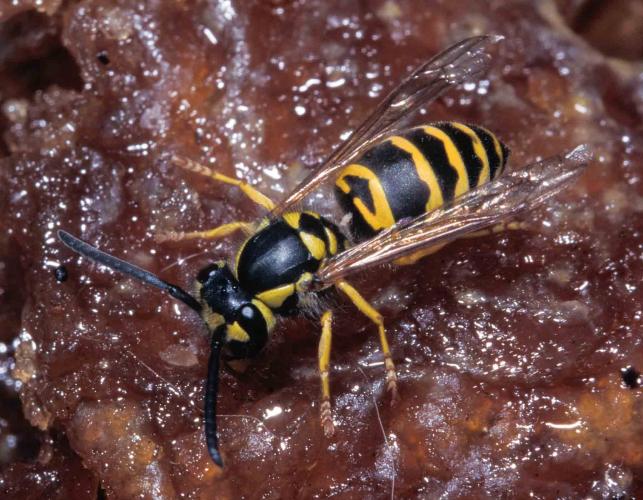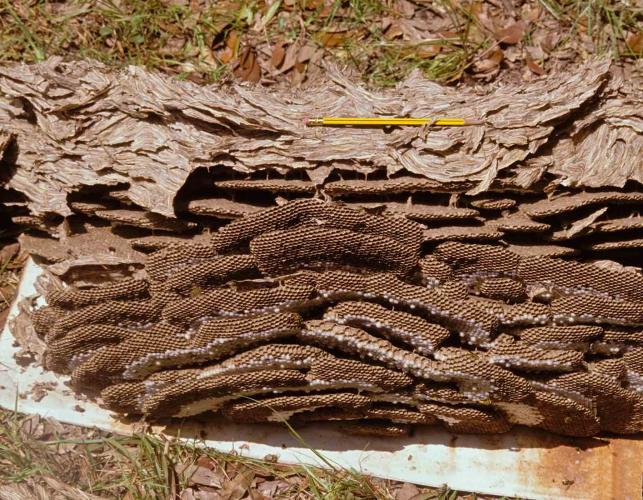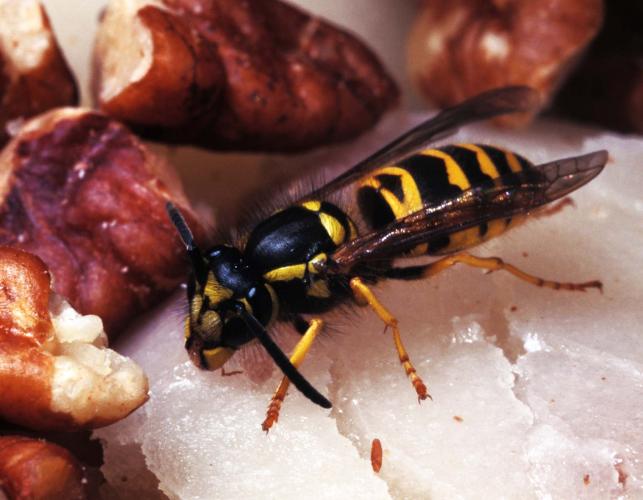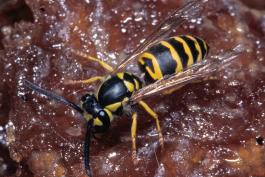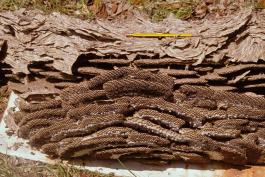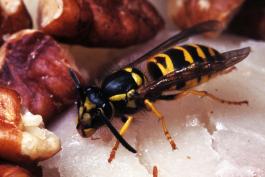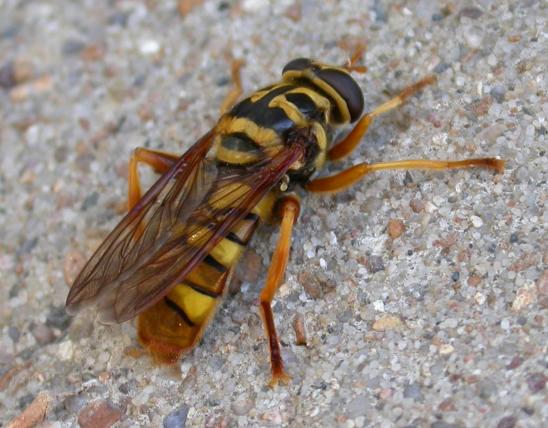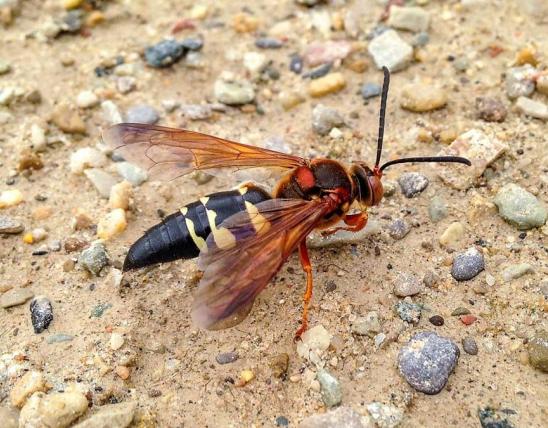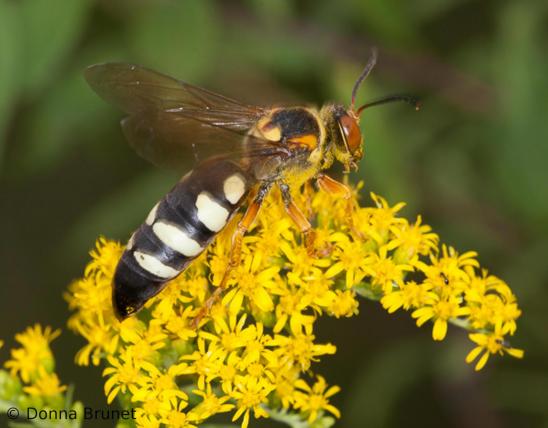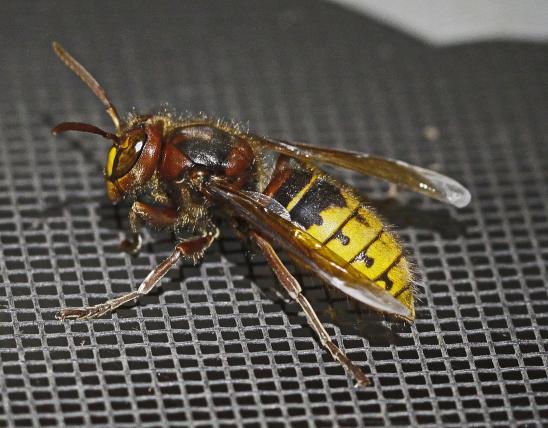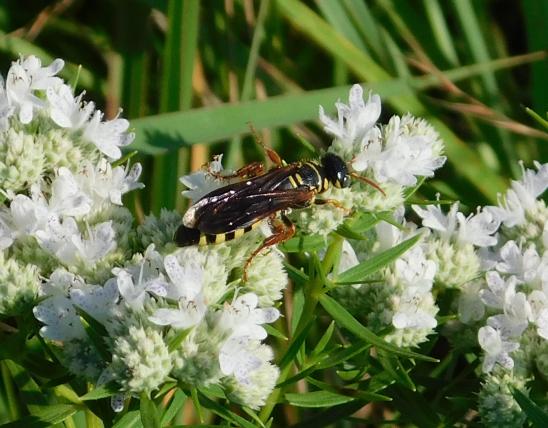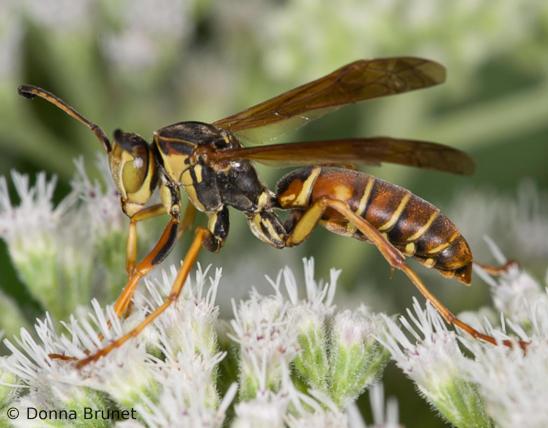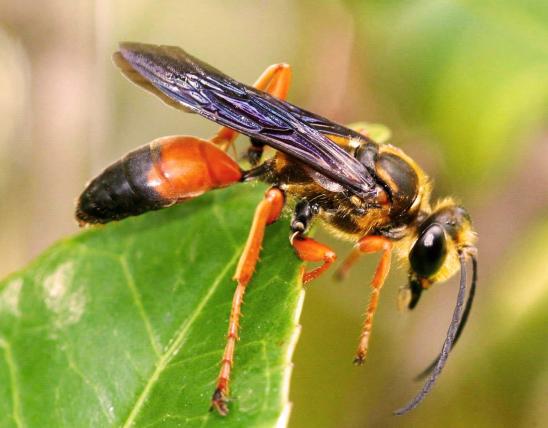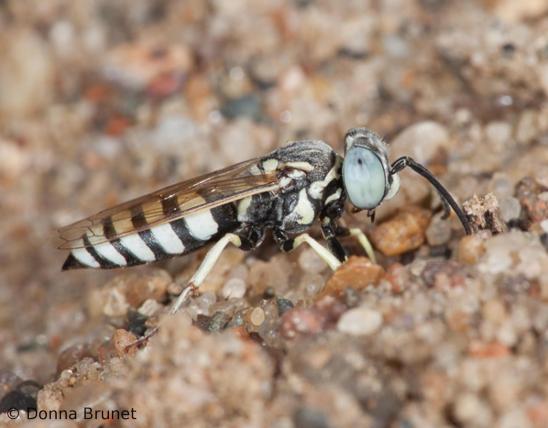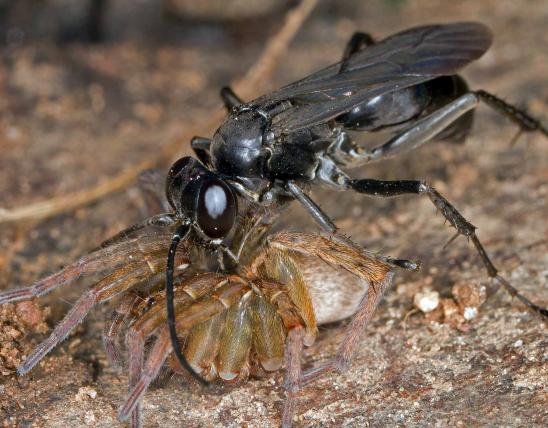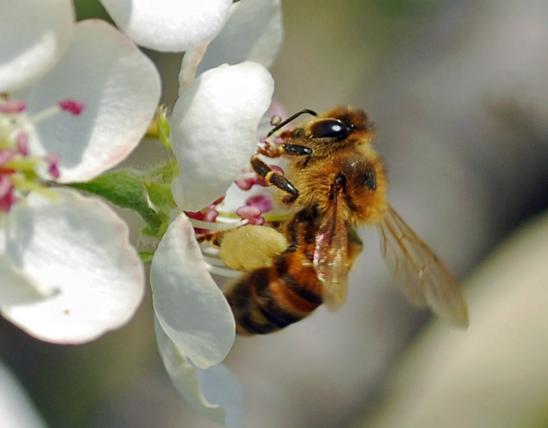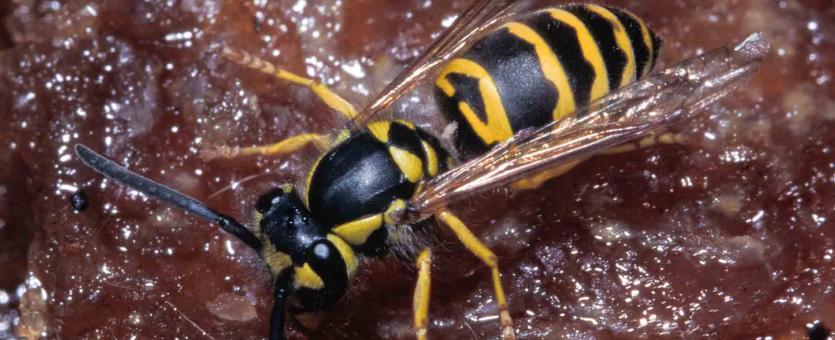
Yellowjackets are bee-sized social wasps that build paper nests, usually underground. They usually have beelike black and yellow bands on their abdomens, but unlike honeybees, they are not densely hairy, nor do they collect pollen. Yellowjackets have yellow or white faces. When resting, they usually hold their wings down their back (not spread out). Right before landing, they often fly quickly side to side.
As with honeybees, yellowjacket queens (large females capable of reproducing), workers (female daughters of the queen), and males usually look somewhat different within each species, which can complicate IDs. The individuals that most people see are the female workers.
Yellowjacket nests are made of paper like those of paper wasps, but they have multiple parallel layers of comb with downward-facing cells (paper wasps always only have a single layer of cells). Yellowjacket nests are always enclosed in a wood-pulp paper envelope built by the wasps. They are most typically constructed underground, and all most people ever see of a nest is the entrance hole with yellowjackets flying in and out of it.
Yellowjackets are widely, and incorrectly, called sweat bees.
Yellowjackets are a significant stinging threat: They nest in colonies and aggressively defend their nest as a group. Individuals can sting repeatedly. Most people only experience localized pain when stung, but some people are severely allergic to wasp and bee stings, and they may experience life-threatening reactions (such as difficulty breathing) if stung. See Human Connections below for more information.
Missouri species include:
- The eastern yellowjacket (Vespula maculifrons) is a very common native Missouri species. It typically builds paper nests underground. Workers and males have a wide, anchor-shaped black marking, with a flat top, on the first abdominal segment. The rest of the segments have black bands that are flat on top and wavy or zigzagged on the bottom edge, but with no free black dots. Queens resemble German yellowjackets but have an anchor-shaped mark, not a diamond, on the first abdominal segment.
- The southern yellowjacket (Vespula squamosa), like the eastern yellowjacket, usually builds its paper nests underground and only rarely in aboveground cavities. It can be distinguished from our other yellowjackets by lengthwise black and yellow stripes on the shoulderlike plate just behind the head. Commonly nests in disturbed habitats and frequently usurps the burrows of eastern yellowjackets: the southern yellowjackets become active later in spring than the eastern yellowjackets, whose many new colonies are just getting started and present ripe pickings for the remarkably large, orangish southern yellowjacket queens. The southern yellowjacket queen kills the eastern yellowjacket queen, adopts her workers, and starts giving birth to her own workers. Eventually, her own worker-offspring constitute the colony as the former queen's workers die off.
- The German yellowjacket (Vespula germanica) is a nonnative wasp that is spreading in North America; it is known to occur in the St. Louis area. Unlike the native eastern yellowjacket, which usually nests underground, the German yellowjacket usually nests in the spaces between walls in buildings; these paper nests can be quite large. Abdomen markings of workers are usually a diamond-shaped black marking on the first segment, and typically a black dot (unattached to a black band) on each side of the rest of the segments.
Similar species: Missouri has many wasps that could be confused with yellowjackets (genus Vespula). Indeed, some people call yellowjackets "ground bees," confusing them with bees, which is another whole group in the ants/bees/wasps order. There are also several types of flies, beetles, and other insects that mimic wasps, too. But here are some of the most common yellowjacket lookalikes:
- The bald-faced hornet (Dolichovespula maculata) is closely related (in the same subfamily), but it is larger and is black with white or ivory-colored markings. They, too, are social wasps that live in colonies. They build large, rounded, papery, gray nests, usually in trees.
- Paper wasps (Polistes spp., in the same family) build paper nests that have only a single layer of cells; these nests are attached on the bottom surface of an overhang, with the cells opening downward. The markings and colorations in this genus vary greatly.
- There are several species of solitary wasps that build nest tunnels underground, including the eastern cicada-killer wasp, great golden digger wasp, great black wasp, sand wasps, and more. Females of these wasps operate individually, or at most, in loose aggregations where several females build their nests in the same general area. Their individual, almost secretive behavior at their burrow entrance separates them from the busy, sometimes even crowded nest openings of yellowjackets.
- The European wasp or giant hornet (Vespa crabro), introduced from Europe, is also present in Missouri. Its large, springtime queens can be nearly 1½ inches long and its workers about ¾ inch long. They are social wasps that build big round, papery nests something like those of bald-faced hornets; the nests of European hornets are typically built in dark hollow locations such as hollow tree trunks, but not underground. Being a large wasp, the European wasp is sometimes confused with the much-hyped, introduced northern giant hornet (a.k.a. Asian giant hornet or "murder wasp," Vespa mandarinia), which is not present in Missouri: in North America, that species has been found only in the Pacific Northwest.
Length: about ½ inch (worker); queens, usually only seen in spring, are larger, usually to about ¾ inch.
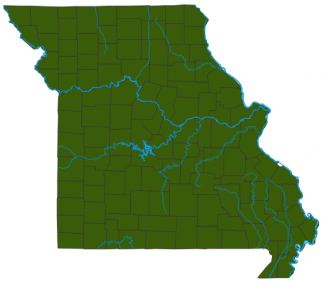
Two native species occur statewide, the eastern yellowjacket (V. maculifrons) and southern yellowjacket (V. squamosa); the introduced German yellowjacket (V. germanica) is expanding its range and will eventually occur statewide, especially in urban areas.
Habitat and Conservation
Missouri's two statewide native species most often nest underground, having started the nest in a cavity such as a rodent burrow.
Yellowjacket nests are made of paper like those of paper wasps, but they have multiple parallel layers of comb, enclosed in a wood-pulp paper envelope. Meanwhile, paper wasps always have only a single layer of paper cells.
Though yellowjackets may have constructed a large paper nest beneath the soil, all you might see is a simple-looking hole in the ground, with wasps flying in and out of it. This is something to watch for if you are out in your yard or are preparing to mow.
Yellowjackets can also nest in trees, attics, and sheds. The nonnative German yellowjacket prefers to build its nests in buildings, not underground, and as it spreads, more people will encounter that species.
As the summer progresses, nests increase in size and in the numbers of wasps they hold, becoming more conspicuous. In late summer, when their nests are at their highest populations and as natural food sources begin to dwindle, yellowjackets are more likely to visit soda cans and garbage containers, and they might be simply more irritable, too.
Food
All three Missouri species feed on a large variety of insects, including many that are injurious to crops, gardens, and landscaping. Larvae, in the nest, are fed such insects, which the adults collect and chew up for them.
Yellowjackets also eat flower nectar, juices from fruits, and other sweets. They may also feed on meat scraps. Because they commonly feed from food scraps, soda cans, and garbage, foraging workers often get close to people and therefore pose potential stinging hazards.
Status
Common. Of our three species, the eastern yellowjacket is the most widespread and common.
Because these are social, not solitary wasps, yellowjackets are willing to protect their family's colony with aggressive stinging. This is one of the wasp genera that can, as groups, chase and sting an intruder who stumbles upon their nests, including people and pets.
People who are allergic to wasp and bee venom (and anyone who doesn't like being stung) should be alert for the signs of yellowjacket nests, usually a hole in the ground with a lot of wasps flying in and out of it. Yellowjackets are usually most active and abundant from midsummer to the first frosts.
Life Cycle
Social ants, bees, and wasps have been called "superorganisms" because the entire colony, and not just an individual creature, undergoes a reproductive life cycle of its own, and no single individual or even pair of individuals is enough to carry through the reproductive cycle; the entire colony is needed. This is one reason why social insects defend their nests so vigorously: each individual may give up its life to defend the whole colony, which shares its genetics and ultimate reproductive destiny.
On the individual level, each yellowjacket, like other ants, bees, and wasps, undergoes complete metamorphosis, similar to that of butterflies and flies. Eggs hatch into grublike larvae that scarcely resemble the adults. They eat and grow, sheltered within a cell of the paper nest, then pupate to become winged adults. Each larva and pupa, whether it is destined to become a female worker, a male, or a queen, matures within a cell of the wasp nest, tended by the worker adults.
The entire colony has its own life cycle: recently mated queens overwinter alone in a protected site such as under bark or in a wood pile. In spring the relatively large queen begins her nest and starts laying eggs, which hatch as female workers. The workers, all females, soon take over the colony’s tasks, allowing the queen to just lay eggs. The colony grows; by September it can contain 5,000 workers, all closely related daughters of the queen. Then the queen lays eggs for males and new queens. Once grown, these leave the nest and mate; the workers, original queen, and males die, and the newly fertilized queens hibernate.
Thus, the entire colony dies once we receive hard frosts and freezes in fall. The only survivors are the fertilized queens, which will overwinter and start new colonies in springtime. Old nests are usually not used again.
Human Connections
Yellowjackets hunt caterpillars, many of which are crop and forest pests, making yellowjackets distinctly beneficial to human interests.
If yellowjackets are a problem for you, yellowjacket traps can offer some relief. Sealing garbage well helps, also. Individual yellowjackets — in a car, or on the lip of a soda can — can be gently nudged away with a piece of paper. Never swat a yellowjacket on your body — it could prompt a sting.
Although these wasps do much that benefits humans, their capacity for colonial, defensive stinging makes them a real concern when they nest near people, especially since some people are allergic to bee and wasp venom. Signs of a severe allergic reaction may include swelling of the face, lips, or throat; breathing difficulties; hives or itching in areas not near the sting; sudden drop in blood pressure; dizziness or lightheadedness; nausea; or loss of consciousness. Also, if a nonallergic person is stung many times at once, it may be enough to produce a severe allergic reaction. If you think you are having a severe allergic reaction to a wasp sting, seek immediate medical help, including calling 911 or other emergency services, as you may not be able to drive yourself to a medical provider. If a doctor has prescribed an emergency epinephrine autoinjector for you, use it right away, as prescribed.
Many people encounter yellowjacket nests when they are mowing a lawn and fail to notice the wasps flying in and out of the hole in the ground that is the entrance to their nest burrow. Before mowing, it's always a good idea to walk the area to look for rocks, sticks, trash, and the nests of animals (including yellowjackets).
If you want to eliminate a yellowjacket nest on your property, we recommend consulting a licensed exterminator. But some nonlethal solutions can allow you to coexist: give them their territory by marking off a safety zone several feet around their nest with surveyor's tape on stakes, or by drawing a boundary with bright spray paint, and wait for the colony to die upon freezing weather.
Indeed, if it is late in the season, it might be best to simply wait for the first hard freeze to put an end to the colony. Natural predators such as skunks may also dig them up and feast on them in the middle of the night. See "ecosystem connections" on this page for more on their beneficial interactions with other types of wildlife.
Yellowjackets' love of sweets causes them to be attracted to soda cans. Sometimes people are stung on the lips when they sip soda out of a can that a yellowjacket is visiting. This is especially common in late summer and fall, so be careful.
If yellowjackets seem unreasonably "mean," remember that they are defending their home and family from what their brains perceive as potential destruction. Many of us are prepared to do basically the same thing, on a personal and even a national level.
People rightly fear yellowjackets and other social wasps that are capable of stinging en masse. But as with many animals that can powerfully affect humans, these wasps have earned a place of respect in our culture. Note, for instance, the many sports teams that are named "yellowjackets," "hornets," and so forth. Proud Missouri high school yellowjackets include Center High School (Kansas City), Glasgow, and Lebanon. Proud Missouri high school hornets include Advance, Chillicothe, Craig, Crystal City, Fulton, Hillcrest (Springfield), Laquey, North Kansas City, Penney (Hamilton), and Westran (Huntsville).
A closely related genus of wasps, Vespa, occurs in Eurasia, with one species, the European hornet (V. crabro) introduced to North America (including Missouri). Vespa means "wasp" in Italian, and it also happens to be the name of one of the world's most iconic makes of motor scooters, the Vespa by Piaggio. Members of genus Vespa are often called the "true hornets."
Folklorist Vance Randolph recorded an oldtime Ozark charm for protecting yourself from yellowjackets: "Jasper whisper jacket! / You caint no more sting me / Than the Devil can count sixpence!"
Ecosystem Connections
Yellowjackets are predators of caterpillars, including many species that are crop and forest pests.
Yellowjackets play a role in pollination.
The black-and-yellow striped pattern of yellowjackets warns predators not to mess with them. The coloration is easily memorized by animals after being stung. Once educated, those animals learn to avoid the wasps. It's a win-win for the yellowjackets and for the animals that have learned the painful lesson.
Yellowjackets are also connected with species that have evolved to have colors and patterns that mimic the black-and-yellow pattern of these stinging insects. Various species of flies, beetles, and moths — completely incapable of stinging — are avoided by predators because of their resemblance to the stinging yellowjackets. A prime example is the yellowjacket hover fly (Milesia virginiensis), which is one of several completely harmless flower flies that look amazingly similar to yellowjackets.
Yellowjackets are also connected to moles, voles, chipmunks, ground squirrels, shrews, snakes, and other animals that create, use, or reuse burrows in the ground. In a wider sense, most burrowing animals are connected to trees that die and whose root systems are eaten away by fungi, creating the start of a hole for burrowing animals to utilize.
Skunks, raccoons, badgers, bears, and other mammals have been known to attack and destroy yellowjacket nests in order to eat the wasp grubs, eggs, and even adults. Skunks typically attack at night when the yellowjackets are least active, digging into the burrow, pawing through the nest, and eating the wasp larvae. If you find that skunks have been pawing holes into your yard at night, they might be saving you from a nest of yellowjackets in your lawn.
Shrews and moles may eat yellowjackets as they burrow underground, too.
